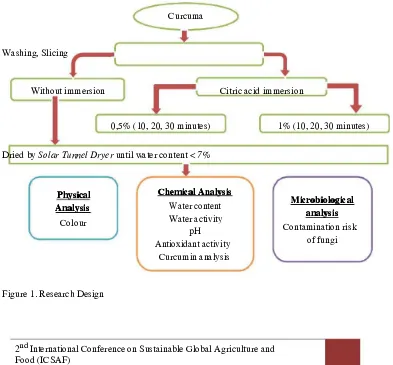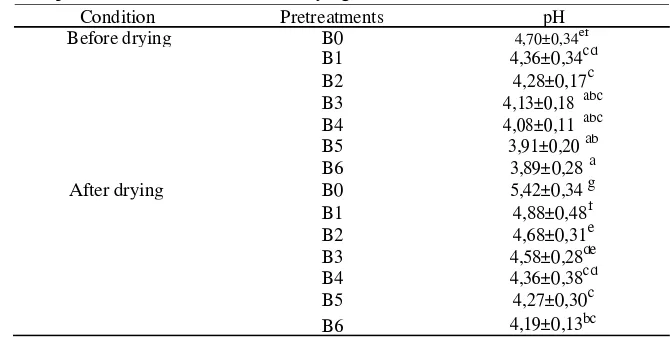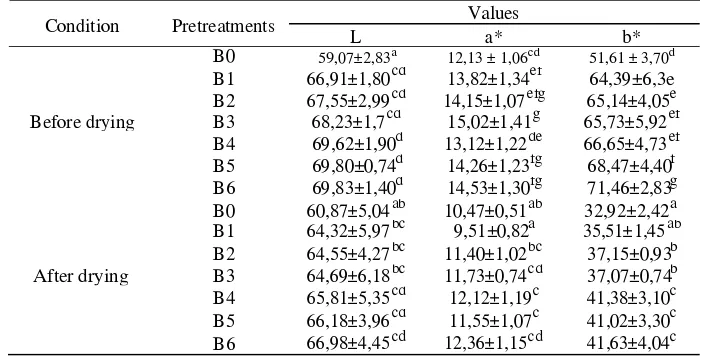97.82%
Originality2.18%
Similarity191
SourcesDoc vs Internet + Library
Web omitted sources: 150 sources found
1. http://repository.unika.ac.id/15946 10.19%
2. http://repository.unika.ac.id/view/year/2016.html 2.21%
3. http://repository.unika.ac.id/view/subjects/G63.html 2.21%
4. http://repository.unika.ac.id/15945 1.56%
5. http://www.biotech.au.edu/index.php?option=com_content&view=article&id=29%3Aa-suchawadee-… 1.56%
6. https://www.swinburne.edu.my/staff/irine-runnie-ginjom.php 1.56%
7. http://proceedings.unika.ac.id 0.98%
8. https://publikasiilmiah.unwahas.ac.id/index.php/Farmasi/article/view/384/500 0.94%
9. http://eprints.dinus.ac.id/12789/1/jurnal_12969.pdf 0.51%
10. https://www.sciencedirect.com/science/article/pii/S0142961216000958 0.51% 11. https://academictree.org/chemistry/publications.php?pid=86965&searchstring=&showfilter=all 0.51% 12. http://repository.unika.ac.id/9131/7/12.70.0052%20William%20Wibowo%20DAFTAR%20PUSTAK… 0.47% 13. https://id.123dok.com/document/4yrokoyo-analisis-pengaruh-cash-ratio-return-on-assets-growth-fi… 0.47%
14. http://ufdc.ufl.edu/UF00028292/00295 0.44%
15. http://ufdc.ufl.edu/UF00028313/00122 0.44%
16. http://ufdc.ufl.edu/UF00028310/00132 0.44%
17. http://ufdc.ufl.edu/UF00028314/00001 0.44%
18. http://ufdc.ufl.edu/UF00028408/00290 0.44%
19. http://ufdc.ufl.edu/UF00028312/00231?search=leonard 0.44%
20. http://ufdc.ufl.edu/UF00028312/00255 0.44%
21. http://ufdc.ufl.edu/UF00028312/00293 0.44%
22. http://ufdc.ufl.edu/UF00028292/00291 0.44%
23. http://ufdc.ufl.edu/UF00027795/04522 0.44%
24. https://www.doa.la.gov/osr/lac/28v81/28v81.doc 0.44%
25. http://ufdc.ufl.edu/UF00028315/01495 0.44%
26. http://ufdc.ufl.edu/UF00028310/00109 0.44%
27. http://ufdc.ufl.edu/UF00028408/00080 0.44%
28. http://ufdc.ufl.edu/UF00028292/00296 0.44%
29. http://ufdc.ufl.edu/UF00028310/00111 0.44%
30. http://ufdc.ufl.edu/UF00028408/00280 0.44%
31. https://unisima.com/salud/suplementos-vitaminas-minerales 0.44%
127. http://etheses.uin-malang.ac.id/5951 0.29%
Library sources: 38 sources found
14.I1.0073-Edwin Widjaja-15 FEB.docx 1.16%
Jurnal Pengaruh Pra Perlakuan terhadap Kualitas Kunyit.pdf 0.8%
2nd ISC (FPE-03).pdf 0.47%
2nd ISC (FPE-03).pdf 0.47%
MARGARETHA-10 MARET.doc 0.44%
MARGARETHA-14 MARET.doc 0.44%
Ayuningtya-4 JUNI.docx 0.44%
ayuningtya saraswati artdiana 13.30.0169.docx 0.44%
Ayuningtya 13.30.0169 REV1.docx 0.44%
Rika Septilya 13.30.0177.docx 0.44%
Rika Septilya13.30.0177 rev1.docx 0.44%
ayuningtya saraswati13.30.0169.docx 0.44%
13.70.0138-Ratna Rahayuningtyas.docx 0.36%
Jurnal Skripsi Susi FIX.docx 0.36%
SKRIPSI CHA 5 jul.docx 0.33%
SKRIPSI CHA 6 jul.docx 0.33%
14.D1.0046 - LIEM INGE HARTONO.docx 0.33%
14.D1.0046- Liem Inge Hartono REV1.docx 0.33%
Betakaroten B5.docx 0.29%
Irmadella (18.I1.0034)_plagscan protein.docx 0.29%
Agnes Sanjaya.docx 0.29%
Alfin N - 13.60.0004 REV5.docx 0.29%
Sie Alfin N - 13.60.0004 Rev4.docx 0.29%
Sie Alfien Natanael 13.60.0004.docx 0.29%
15.E3.0020-Udyaksa Pratista Nugrahani (1).docx 0.29%
YEFTA-6 JUNI.docx 0.29%
LAKSITA-3 MARET.docx 0.29%
B6 (3).docx 0.29%
B3 (3).docx 0.29%
Albertin Winda-29 MEI.doc 0.29%
Bab Telur_B1.doc 0.29%
14.D2.0008-Ian Satrio Ecky Gusti-9 MEI.doc 0.29%
Angela Saraz.docx 0.29%
15.I1.0035-OLIVIA-TUGAS-3 APRIL.docx 0.29%
ECKY-6 MARET.docx 0.29%
ADYTIA-7 FEB.docx 0.29%
12.40.0219-MERY AMELIA PUTRI.docx 0.29%
Library omitted sources: 3 sources found
2nd ICSAF 2016 (Hal 201) (1).pdf 100%
2nd ICSAF 2016 (Hal 78) (1).pdf 5.88%
Impact of Citric A
Impact of Citric Acid Imm
cid Immersion on the P
ersion on the Physicochem
hysicochemical and
ical and
Microbiologica
Microbiological Characteri
l Characteristics of Curc
stics of Curcuma D
uma Dried with Solar Tunne
ried with Solar Tunnel
l
Dryer
Dryer
Victoria Kristina Ananingsih, R. Probo Y. Nugrahedi, Fr
Victoria Kristina Ananingsih, R. Probo Y. Nugrahedi, Fransisca Sariansisca Sari
Food Technolog
Food Technology Department, Soegijapranatay Department, Soegijapranata Catholic Univers Catholic University,Semarangity,Semarang-Indonesia Email: -Indonesia Email: [email protected]
Curcuma (Curcuma xanthorrhiza Roxb) is a kind of rhyzome that is usually used as raw material for making Jamu (traditional drink in Indonesia). Solar tunnel drying can be applied to extend the shelf life of fresh curcuma due to the reducing of its water content. Drying process could change the physicochemical properties of dried curcuma such as discoloration and degradation of chemical compounds because the use of high temperature during solar tunnel drying. To reduce the negative effects of drying process, pretreatment can be applied before drying process. Citric acid immersion is one of the drying pretreatment that could prevent the damage of curcuma during drying. The purpose of this study was to determine the effect of citric acid concentration and immersion time in maintaining the quality of dried curcuma. Two levels of citric acid concentration were applied, i.e. 0.5% and 1%, while 3 levels of immersion time were conducted, i.e. 10, 20 and 30 minutes. Curcuma was dried until its moisture content less than 7%. Curcuma processed with 1% citric acid and immersion time of 30 minutes provided superior qualities that resulted in the fastest drying time (255 minutes), produced the highest % inhibition (92.14%) and the highest curcumin content (5.34%), also showed the minimum possibility of fungal growth.
Keywords : curcuma, solar tunnel drying, pretreatment, citric acid
INTRODUCTION INTRODUCTION
Curcuma (Curcuma xanthorrhiza Roxb.) is a kind of rhyzomes grown in Indonesia which contains high antioxidant especially curcuminoid. It is used as natural colorant, and ingredients for making Indonesian traditional herbal drink (Sudrajad & Azar, 2004). The main bioactive compound of curcuma is curcuminoid, others are essential oil, flavoloid and tannin (Rukmana, 1995). Curcumin, one of the curcuminoid compounds, contributes to the yellow color (Tensiska., Nurhadi, B., dan Isfron, 2012) and it acts as antioxidant (Masuda, Isobe, Jitoe, & Nakatani, 1992). Curcumin is stable in the acid condition (Tonnesen & Karslen, 2007). Citric acid is an organic acid which is applied as drying pretreatment to prevent the physical and chemical changes of foodstuff after drying.
2nd International Conference on Sustainable Global Agriculture and Food (ICSAF)
“Safeguarding Global Consumers: Innovation in Food Science and201 Technology”
The shelf life of curcuma can be extended by drying process to reduce its water content and water activity. One of drying methods that is applicable for tropical countries is
Solar Tunnel Drying. Temperature of Solar Tunnel Dryer is 60-70 C which is suitabo le to dry the foodstuff. Before the drying process, pretreatment can be applied to improve the qualities of dried curcuma, which is immersion in the citric acid solution.
Immersion in the citric acid solution is proposed to prevent the damage of dried curcuma after the drying process, accelerate the drying time and reduce the degradation of antioxidant. The purpose of this research is to study the impact of citric acid immersion on the qualities of curcuma dried by Solar Tunnel Dryer.
METHODS METHODS
Curcuma
Washing, Slicing
Without immersion Citric acid immersion
0,5% (10, 20, 30 minutes) 1% (10, 20, 30 minutes)
Dried by Solar Tunnel Dryer until water content < 7%
Physical
Physical Chemical Analysis Chemical Analysis MicrobMicrobiologiciologicalal Water content
Analysis Analysis
analysis analysis Water activity
Colour Contamination risk
pH
of fungi
Antioxidant activity
Curcumin analysis
Figure 1. Research Design
2nd International Conference on Sustainable Global Agriculture and Food (ICSAF)
“Safeguarding Global Consumers: Innovation in Food Science and202 Technology”
Curcuma is washed, sliced and immersed in the 0.5% and 1% of citric acid for 10.20 and 30 minutes. Then, the samples were dried by Solar Tunnel Dryer until their water contents were lower that 7%. The dried curcuma was analyzed for the physical characteristic (color intensity), chemical characteristics (water content, water activity, pH, antioxidant activity and curcumin content), and microbiological characteristic (contamination risk of fungi). Antioxidant activity was analyzed by DPPH method, while curcumin was analyzed by spectrophotometric method.
Pretreatments conducted in this research were : B0 = Control/without immersion; B1 = 0,5% Citric acid + 10 min immersion; B2 = 0,5% Citric acid + 20 min immersion; B3 = 0,5% Citric acid + 30 min immersion; B4 = 1% Citric acid + 10 min immersion; B5 = 1% Citric acid + 20 min immersion; B6 = 1% Citric acid + 30 min immersion;
2nd International Conference on Sustainable Global Agriculture and Food (ICSAF)
“Safeguarding Global Consumers: Innovation in Food Science and203 Technology”
RESULTS AND DISCUSSION RESULTS AND DISCUSSION
WATER CONTENTS DURING DRYING WATER CONTENTS DURING DRYING
Degradation of water contents during solar tunnel drying can be seen in Table 1.
Tabel13. Degradation of water contents during Solar Tunnel Drying
Waktu B0 B1 B2 B3 B4 B5 B6
0 72,70±0,13 80,77±0,05 82,16±0,02 84,92±0,01 81,25±0,02 81,93±0,03 82,04±0,01
15 66,24±0,12 72,94±0,07 76,21±0,04 78,88±0,05 76,45±0,05 77,04±0,06 78,32±0,04
30 62,16±0,11 67,36±0,10 73,34±0,06 75,25±0,06 72,62±0,05 72,89±0,07 73,39±0,05
45 59,18±0,10 63,34±0,10 71,15±0,06 70,82±0,07 69,48±0,06 69,17±0,07 69,69±0,04
60 57,66±0,10 59,57±0,10 68,75±0,06 67,42±0,07 65,00±0,05 65,43±0,07 63,67±0,05
75 54,23±0,10 55,22±0,11 66,23±0,06 62,77±0,05 60,79±0,06 60,57±0,06 57,23±0,08
90 51,06±0,09 52,40±0,10 62,94±0,06 57,76±0,06 55,84±0,06 53,15±0,05 49,53±0,10
105 49,11±0,10 49,13±0,09 59,57±0,07 50,46±0,76 50,97±0,07 43,85±0,04 40,80±0,11
120 45,86±0,09 43,97±0,09 53,83±0,07 42,44±0,08 44,83±0,07 34,22±0,04 34,21±0,10
135 36,08±0,04 37,99±0,08 47,15±0,07 35,10±0,08 38,70±0,07 27,46±0,04 28,72±0,09
150 28,19±0,03 32,87±0,08 41,32±0,08 29,35±0,06 33,57±0,07 21,47±0,05 23,94±0,09
165 23,74±0,02 28,11±0,07 35,84±0,07 23,85±0,05 28,02±0,07 17,11±0,04 18,52±0,07
180 18,19±0,02 22,96±0,06 29,73±0,07 19,21±0,04 22,27±0,06 13,68±0,04 14,41±0,05
195 14,85±0,02 18,65±0,04 25,17±0,06 15,73±0,03 17,77±0,05 11,55±0,03 10,86±0,03
210 12,62±0,02 15,51±0,03 20,86±0,05 11,82±0,01 13,51±0,04 9,34±0,02 8,11±0,02
225 10,61±0,02 12,48±0,02 16,65±0,05 9,89±0,02 9,94±0,02 7,49±0,02 6,30±0,02
240 8,39±0,01 10,25±0,02 13,00±0,04 6,85±0,01 8,08±0,01 6,15±0,01 5,70±0,01
255 8,05±0,02 8,15±0,02 9,55±0,03 6,41±0,01 6,36±0,01 - -
Curcuma was dried until the water content was lower than 7%. It is purposed to reduce the water content and inhibit the growth of fungi. Table 1 revealed that the fastest drying time was B6 (immersion in the 1% citric acid for 30 minutes). This pretreatment would open the pores of the cell wall hence the water could be evaporated faster (Pangavhane, Sawhney, & Sarsavadia, 1999). The results showed that higher temperature of solar tunnel dryer produced higher drying rate. Velic, Darko (2007) said that higher drying temperature resulted in higher drying time (Velić, Tomas, & Bucić kojić, 2007).
-PH OF CURCUMA PH OF CURCUMA
Table 14. pH of curcuma before and after drying
Condition Pretreatments pH
Before drying B0 4,70±0,34ef
Table 15. pH of citric acid solution
It can be seen in Table 2 that pH of fresh curcuma was lower than dried curcuma. This is due to the immersion pretreatment in the citric acid. Citric acid reduced the pH and retained the
color of dried curcuma because it inhibited the activity of phenolaze enzyme. This enzyme contributes to the browning process. The immersion solution had the pH
2nd International Conference on Sustainable Global Agriculture and Food (ICSAF)
“Safeguarding Global Consumers: Innovation in Food Science and205 Technology”
around 2.01-2.39. At this range of pH, the activity of phenolaze enzyme is low; hence it reduces the browning reaction.
CURCUMIN CONTENTS CURCUMIN CONTENTS
Table 16. Curcumin contents before and after drying
Condition Pretreatments Curcumin contents (ppm) Wet Basis Dry Basis Before Drying B0 540,51± 26,67a 1093,63±334,45b
B1 392,80±86,94e 2225,38±898,34 c B2 181,56±17,90b 1025,16±134,83 b B3 168,72±27,23 b 1121,38±209,02 b B4 253,212±8,93c 1375,33±226,18 b B5 350,213±145,80d 2059,35±1101,33c B6 361,62±10,98de 2028,42±211,53 c After Dyring B0 502,78±22,61e 540,51±26,66a
B1 509,82±27,46 f 547,60±27,58 a
Table 4 showed that curcumin content (dry basis) decreased significantly due to it was easily degraded during drying. The curcumin content in the dried curcuma was higher than the fresh one. During drying, the cell wall of oleoresin was broken hence curcumin was detected higher.
ANTIOXIDANT ACTIVITY (% INHIBITION) ANTIOXIDANT ACTIVITY (% INHIBITION)
Table 17. % Inhibition of curcuma before and after drying
Condition Pretreatments Wet Basis % Inhibibition Dry Basis
Before drying B0 62,07±3,00b 271,68±106,37 c
2nd International Conference on Sustainable Global Agriculture and Food (ICSAF)
“Safeguarding Global Consumers: Innovation in Food Science and206 Technology”
B2 88,07±3,57e 94,36±1,25b
B3 88,51±2,36e 106,87±1,26 b B4 88,86±1,94ef 94,89±2,30 b B5 90,95±0,85ef 96,92±1,18 b B6 92,14±2,61f 97,73±2,74 b
Table 4 showed the degradation of antioxidant which caused by the drying process. Pretreamen B6 (immersion in the 1% citric acid for 30 minutes) produced the highest % inhibition. Citric acid caused the fastest drying time, therefore it could retained the active compound of dried curcuma.
WATER ACTIVITY (AW) WATER ACTIVITY (AW)
Table 18. Water activity of curcuma
Condition Pretreatments Aw
Before drying B0 0,982±0,01e
B1 0,976±0,02e
B2 0,973±0,02e
B3 0,980±0,01e
B4 0,964±0,03e
B5 0,969±0,03e
B6 0,964±0,03e
After drying B0 0,577±0,06d
B1 0,466±0,10c
B2 0,403±0,10abc B3 0,417±0,12abc B4 0,389±0,08ab B5 0,442±0,09bc
B6 0,348±0,10a
The water activity of curcuma reduced significantly after drying, which were around 0,348 – 0,984. This low water activity can extend the shelf life of dried curcuma. Labuza (1980) said that dried food which has the water activity lower than 0.6 is categorized as dried food that resistant to the growth of microorganisms.
2nd International Conference on Sustainable Global Agriculture and Food (ICSAF)
“Safeguarding Global Consumers: Innovation in Food Science and207 Technology”
CONTAMINATION RISK OF FUNGI CONTAMINATION RISK OF FUNGI
Table 19. Contamination risks of fungi of dried curcuma(%)
Condition Pretreatment Total fungi (%)
After drying B0 27,78±9,72 a
Contamination risks of fungi for all samples were not significantly different. Pretreatment B6 had the lowest contamination risk of fungi which was 15,56%. Citric acid inhibits the grow of fungi due to its low pH and it acts as chellating agent which binds the metal ion which functions to absorb the nutrition through the cell wall of fungi. Therefore, the fungi will difficult to grow. Moreover, the low water activity inhibits the growth of fungi. In the low water activity, the fungi does not has enough water, hence they can not grow (Guo et al., 2016).
COLOR INTENSITY COLOR INTENSITY
Tabel 20. Color intensity of curcuma before and after drying
Condition Pretreatments Values
L a* b*
2nd International Conference on Sustainable Global Agriculture and Food (ICSAF)
“Safeguarding Global Consumers: Innovation in Food Science and208 Technology”
Table 8 showed that measurement of color intensity of dried curcuma produced higher L*, a* b* values compared to those of fresh curcuma. The higher L* and b* values showed the increase level of lightness and yellow color of dried curcuma. Citric acid could reduce the browning reaction because it contributed to the lower pH (Nurdjannah & Hoerudin, 2008). The low pH of curcuma can be seen in Table 2.
CONCLUSION CONCLUSION
Pretreatment B6 which was immersion in the 1% citric acid solution for 30 minutes could accelerate the drying time (240 minutes) compared to that without pretreatment (270 minutes). This pretreatment could also produce dried curcuma that had high % inhibition (97,73%, dry basis), high curcumin content (565,97 ppm, dry basis) and low contamination risk of fungi (15,56%)
REFERENCES REFERENCES
Guo, J., Wang, W., Hu, J., Xie, D., Gerhard, E., Nisic, M., … Yang, J. (2016). Synthesis and characterization of anti-bacterial and anti-fungal citrate-based mussel-inspired bioadhesives. Biomaterials 85, , 204 217. –
Labuza, T. P. (1980). Effect of water activity on reaction kinetics of food deterioration. Food Technol. New York.
Masuda, T., Isobe, J., Jitoe, A., & Nakatani, N. (1992). Antioxidative curcuminoids from rhizomes of Curcuma xanthorrhiza. Phytochemistry 31, (10), 3645 3647. –
Nurdjannah, N., & Hoerudin. (2008). Pengaruh Perendaman Dalam Asam Organik Dan Kering, XIX(2), 181 196. –
Pangavhane, D. R., Sawhney, R. L., & Sarsavadia, P. N. (1999). Effect of various dipping pretreatment on drying kinetics of Thompson seedless grapes. Journal of Food Engineering, 39(2), 211 216. –
Rosidi, A., Khomsan, A., Setiawan, B., & Briawan, D. (2004). Potensi temulawak (c, (1995).
Rukmana, Ir Rahmat. 1995. Temulawak: Tanaman rempah dan obat. Penerbit Kanisius. Yogyakarta
Singleton V.L. & Rossi J.A. Jr. Colorunetry of Total Phenolic With
Phosphomolybdic-Phosphotungstic Acid Reagent. Amer. J. Enol. Viticult. 16:144-58, 1965.
2nd International Conference on Sustainable Global Agriculture and Food (ICSAF)
“Safeguarding Global Consumers: Innovation in Food Science and209 Technology”
Sudrajad, H., & Azar, F. Al. (2004). Uji Aktivitas Antifungi Minyak Atsiri Rimpang Temulawak (Curcuma xanthorriza Roxb.) secara In Vitro Terhadap Candida albicans. Balai Besar Penelitian Dan Pengembangan Tanaman Obat Dan Obat Tradisional,84–89.
Tensiska., Nurhadi, B., dan Isfron, A. . (2012). Kestabilan warna kurkumin terenkapsulasi dari kunyit (, 14(3), 198 206. –
Tonnesen, H. H., & Karslen, J. (2007). Studies on curcumin and curcuminoids. International Journal of Pharmaceutics 338, (1-2), 27 34. –
Velić, D., Tomas, S., & Bucić kojić, A. (2007). Study of the Drying Kinetics of “ Granny -Smith ” Apple in Tray Drier. Agriculturae Conspectus Scientificus, 72(4), 323–328.
2nd International Conference on Sustainable Global Agriculture and Food (ICSAF)
“Safeguarding Global Consumers: Innovation in Food Science and210 Technology”




